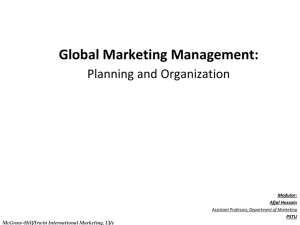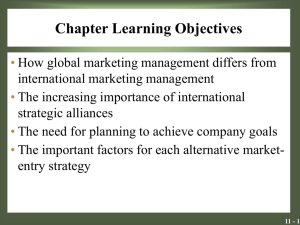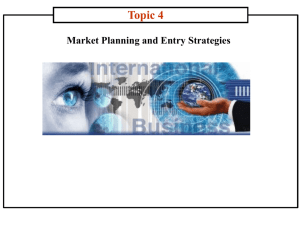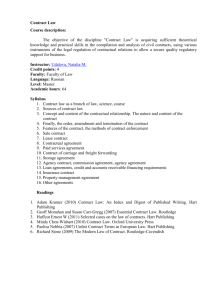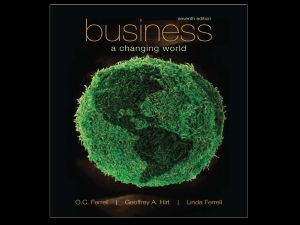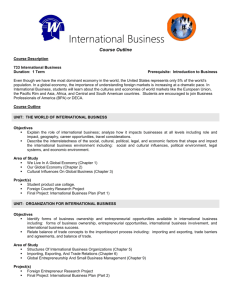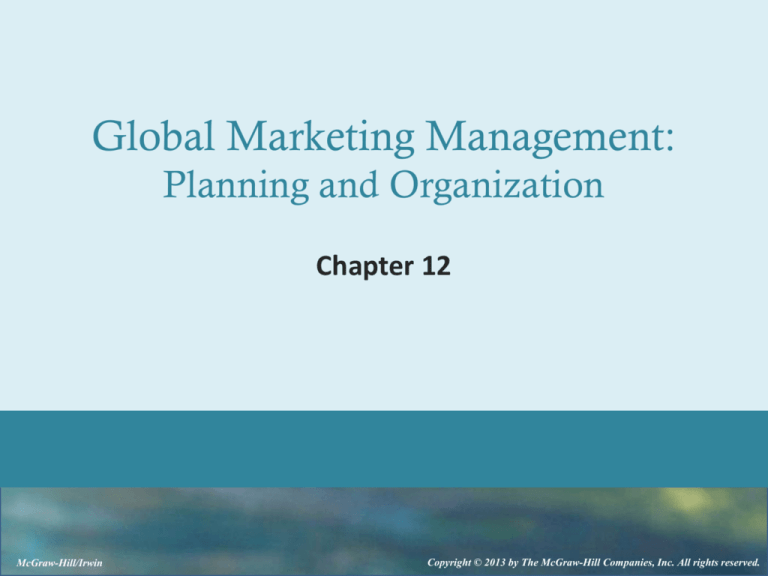
Global Marketing Management:
Planning and Organization
Chapter 12
McGraw-Hill/Irwin
Copyright © 2013 by The McGraw-Hill Companies, Inc. All rights reserved.
Learning Objectives
LO1 How global marketing management differs from
international marketing management
LO2 The need for planning to achieve company goals
LO3 The important factors for each alternative
market entry strategy
LO4 The increasing importance of international
strategic alliances
12-2
Global Marketing Management
• “standardization
vs. adaptation”
1970s
1980s
• “globalization
vs. localization”
• “global
integration vs.
local
responsiveness”
1990s
12-3
Global Marketing Management
The issue is if the global homogenization of
consumer tastes allow for the global standardization
of the marketing mix
The Internet revolution of the 1990s added a new
twist to the old debate
Some companies continue to believe that “global” is
the way to go
12-4
Global Marketing Management
In many parts of the world, consumers have become
pickier, more penny-wise, or a little more nationalistic
They are spending more of their money on local drinks
whose flavors are not part of the Coca-Cola lineup
The trend back toward localization is because of the
efficiencies of customization because of the proliferation
of the Internet and flexible manufacturing processes
12-5
12-6
Global Marketing Management
The debate about standardization versus adaptation
is an example of ethnocentrism in the U.S.
As global markets homogenize and diversify
simultaneously, the best companies will avoid
focusing on country as the primary segmentation
variable
Other segmentation variables are often more
important—for example, climate, language group,
media habits, age, or income
12-7
The Nestlé Way:
Evolution Not Revolution
The “Nestlé way” is to dominate its markets
Its overall strategy can be summarized in four points:
Think and plan long term
Decentralize
Stick to what you know
Adapt to local tastes
12-8
Benefits of Global Marketing
Economies of scale in production and marketing
Transfer of experience and know-how across
countries
Global diversity in marketing talent leading to new
approaches
Marketing globally ensures that marketers have
access to the toughest customers
Spreading the portfolio of markets brings stability of
revenues and operations to many global companies
12-9
Planning for Global Markets
Planning is a systematized way of relating to the future
It is a commitment of resources to a country market to
achieve specific goals
It allows for rapid growth of the international function and the
challenges of different national markets
International corporate planning is essentially long term
incorporating generalized goals for the enterprise as a whole
Strategic planning deals with products, capital, research, and
the long- and short-term goals of the company
Tactical planning , or market planning, pertains to specific
actions and to the allocation of resources to implement goals
12-10
Company Objectives and Resources
Foreign market opportunities do not always parallel
corporate objectives and resources
It may be necessary to change the objectives, alter
the scale of international plans, or abandon them
One market may offer immediate profit but have a
poor long-run outlook, while another may offer the
reverse.
Only when corporate objectives are clear can such
differences be reconciled effectively
12-11
International Commitment
Management needs to be prepared to make the level of
commitment required for successful international
operations
Commitment affects the specific international strategies
and decisions of the firm
A long-term marketing plan should have realistic time
goals set for sales growth
There is a strong regional preference for multinational
companies as they expand their operations
Competition and the ease of communications is forcing
managers to make commitments to global marketing
12-12
12-13
Phase 1: Preliminary Analysis
and Screening
A critical first step in the planning process is deciding in which
existing country market to make a market investment
A company’s strengths and weaknesses, products,
philosophies, modes of operation, and objectives must be
matched with a country’s qualities
First, countries are analyzed and screened to eliminate those
that do not offer sufficient potential for further consideration
Second, screening criteria are established against which
prospective countries can be evaluated
Third, a complete analysis of the environment within which a
company plans to operate is made
12-14
Phase 2: Defining Target Markets and
Adapting the Marketing Mix
A more detailed examination of the components of the
marketing mix is the purpose of Phase 2
The primary goal of Phase 2 is to decide on a marketing
mix adjusted to the cultural constraints imposed by the
uncontrollable elements of the environment that
effectively achieves corporate objectives and goals
The answers to three major questions are generated in
Phase 2:
• Are there identifiable market segments that allow for common
marketing mix tactics across countries?
• Which cultural/environmental adaptations are necessary for
successful acceptance of the marketing mix?
• Will adaptation costs allow profitable market entry?
12-15
Phase 3: Developing the Marketing Plan
A marketing plan is developed for the target
market—whether it is a single country or a global
market set
The marketing plan begins with a situation analysis
and culminates in the selection of an entry mode and
a specific action program for the market
The specific plan establishes what is to be done, by
whom, how it is to be done, and when. Included are
budgets and sales and profit expectations
12-16
Phase 4: Implementation and Control
The planning process is a dynamic, continuous set of
interacting variables with information continuously
building among phases
An evaluation and control system requires performanceobjective action; bringing the plan back on track should
standards of performance fall short
The system encourages the decision maker to consider all
variables that affect the success of a company’s plan
It provides the basis for viewing all country markets and
their interrelationships as an integrated global unit
12-17
Alternative Market-Entry Strategies
A company has four different modes of foreign
market entry from which to select: exporting,
contractual agreements, strategic alliances, and
direct foreign investment
The amount of equity required by the company to
use different modes affects the risk, return, and
control that it will have in each mode
12-18
Exhibit 12.2 Alternative Market-Entry Strategies
12-19
Exporting
Exporting accounts for some 10 percent of global
economic activity.
Exporting can be either direct or indirect:
• With direct exporting , the company sells to a customer in
another country
• With indirect exporting usually means that the company
sells to a buyer (importer or distributor) in the home
country, which in turn exports the product
12-20
Exporting
The Internet
• The Internet is becoming increasingly important as a
foreign market entry method
• Should not be overlooked as an alternative market entry
strategy by the small or large company
Direct Sales
• A direct sales force may be required particularly for hightechnology and big ticket industrial products
• It may mean establishing an office with local and/or
expatriate managers and staff, depending of course on the
size of the market and potential sales revenues.
12-21
Contractual Agreements
Contractual agreements are long-term, non equity
associations between a company and another in a
foreign market.
Contractual agreements generally involve the
transfer of technology, processes, trademarks,
and/or human skills. In short, they serve as a means
of transfer of knowledge rather than equity.
12-22
Contractual Agreements
Contractual agreements are long-term, non equity
associations between a company and another in a
foreign market
Contractual agreements involve the transfer of
technology, processes, trademarks, and/or human
skills.
They serve as a means of transfer of knowledge
rather than equity
12-23
Contractual Agreements: Licensing
Licensing is a means of establishing in foreign markets
without large capital outlays
Includes patent rights, trademark rights, and the rights to use
technological processes
12-24
Contractual Agreements: Licensing
Advantages
• capital is scarce
• import restrictions forbid
other means of entry
• a country is sensitive to
foreign ownership or
• patents and trademarks must
be protected against
cancellation for nonuse.
Risks
• choosing the wrong partner
• quality and other production
problems
• payment problems
• contract enforcement and
• loss of marketing control
12-25
Contractual Agreements: Franchising
Franchising is a rapidly growing form of licensing
The franchiser provides a standard package of products,
systems, and management services, and the franchisee
provides market knowledge, capital, and personal
involvement in management
The combination of skills permits flexibility in dealing
with local market conditions and yet provides the parent
firm with a reasonable degree of control.
The franchiser can follow through on marketing of the
products to the point of final sale
It is an important form of vertical market integration
12-26
Contractual Agreements: Franchising
The franchise system provides an effective blending of
skill centralization and operational decentralization
In spite of the economic downturn, franchising is still
expected to be the fastest growing market-entry strategy
Franchises were often among the first types of foreign
retail business to open in the emerging market
economies of eastern Europe, the former republics of
Russia, and China
The franchising system combines the knowledge of the
franchiser with the local knowledge and entrepreneurial
spirit of the franchisee
12-27
Strategic International Alliances (SIAs)
A strategic international alliance (SIA) is a business
relationship established by two or more companies to
cooperate out of mutual need and to share risk in achieving a
common objective
Strategic international alliances are sought as a way to shore
up weaknesses and increase competitive strengths;
complementarity is key.
Firms enter into SIAs for several reasons:
•
•
•
•
•
•
opportunities for rapid expansion into new markets
access to new technology
more efficient production and innovation
reduced marketing costs
strategic competitive moves and
access to additional sources of products and capital.
12-28
12-29
Strategic International Alliances:
International Joint Ventures (IJVs)
A joint venture is different from other types of strategic
alliances or collaborative relationships in that a joint
venture is a partnership of two or more participating
companies that have joined forces to create a separate
legal entity.
Four characteristics define joint ventures:
• JVs are established, separate, legal entities
• they acknowledge intent by the partners to share in the
management of the JV
• they are partnerships between legally incorporated entities and
not between individuals and
• equity positions are held by each of the partners
12-30
Strategic International Alliances:
Consortia
Consortia are similar to joint ventures and except for
two unique characteristics:
• they typically involve a large number of participants
• they frequently operate in a country or market in which
none of the participants is currently active
Consortia are developed to pool financial and
managerial resources and to lessen risks
One firm usually acts as the lead firm, or the newly
formed corporation may exist independently of its
originators
12-31
Direct Foreign Investment
Direct foreign investment is direct investment within
a foreign country
Companies may invest locally to:
•
•
•
•
•
capitalize on low cost labor
avoid high import taxes
reduce the high costs of transportation to market
gain access to raw materials and technology or
as a means of gaining market entry
Firms may either invest in or buy local companies or
establish new operations facilities
12-32
Direct Foreign Investment
Several factors have been found to influence the
structure and performance of direct investments:
•
•
•
•
•
•
timing—first movers have advantages but are more risky
the growing complexity and contingencies of contracts
transaction cost structures
technology and knowledge transfer
degree of product differentiation
the previous experiences and cultural diversity of acquired
firms
• advertising and reputation barriers
12-33
Organizing for Global Competition
Companies are usually structured around one of
three alternatives
• global product divisions responsible for product sales
throughout the world
• geographical divisions responsible for all products and
functions within a given geographical area
• a matrix organization consisting of either of these
arrangements with centralized sales and marketing run by
a centralized functional staff, or a combination of area
operations and global product management
12-34
12-35
Locus of Decision
Relates to where decisions will be made, by whom,
and by which method
Management policy must be explicit about which
decisions are to be made at which level
Most companies limit the amount of money to be
spent at each level
Decision levels for determination of policy, strategy,
and tactical decisions must be established
Tactical decisions are usually made at the lowest
possible level
12-36
Centralized versus Decentralized
Organizations
Organizational patterns for the headquarters’
activities of multinational firms usually fit into one of
three categories:
• Centralized
• Regionalized
• Decentralized
The advantages of centralization are:
• the availability of experts at one location
• the ability to exercise a high degree of control on both the
planning and implementation phases
• the centralization of all records and information
12-37
Centralized vs. Decentralized
Organizations
Some companies implement extreme
decentralization by giving selecting competent local
managers full responsibility for national or regional
operations
Even though product decisions may be highly
centralized, subsidiaries may have a substantial
amount of local influence in pricing, advertising, and
distribution decisions
If a product is culturally sensitive, the decisions are
more likely to be decentralized
12-38

